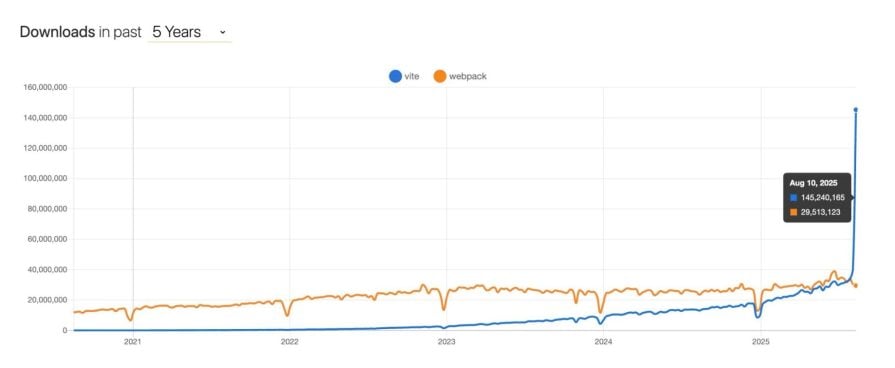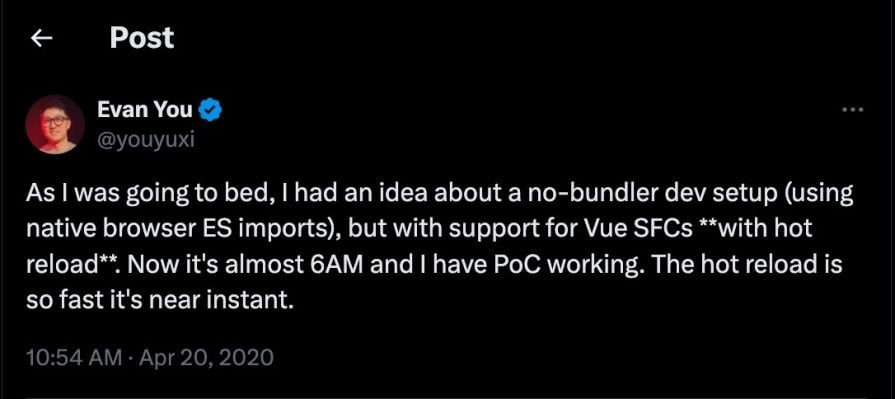The silent shift to Vite: What it means for your stack
This year, Vite crossed 140 million weekly downloads, surpassing Webpack and continuing its upward trend.
It’s a wild milestone, considering Webpack was the cornerstone bundler for JavaScript for a very long time, and few would have predicted Vite overtaking it. With Vite, developers now enjoy faster build times and instant hot reloads, which means the next generation may never know the pain of waiting minutes to start a dev server.
To better understand this shift, let’s look at the early build tools and how Webpack rose to popularity. We’ll also explore why developers are now moving toward Vite, and how you should react moving forward:
Source: npm trend
The early build tools
Before modern build tools took over, frontend developers relied on task runners. The most popular was Grunt and later Gulp. With Grunt, you wrote a big configuration file describing what you wanted done, as shown below:
module.exports = function (grunt) {
grunt.initConfig({
concat: { dist: { src: ['src/*.js'], dest: 'dist/app.js' } },
uglify: { dist: { files: { 'dist/app.min.js': ['dist/app.js'] } } }
});
grunt.loadNpmTasks('grunt-contrib-concat');
grunt.loadNpmTasks('grunt-contrib-uglify');
grunt.registerTask('default', ['concat', 'uglify']);
};
Then Grunt would march through that list task by task. It was a relief compared to running each step manually, but it also meant managing endless plugins and keeping a massive config in sync.
Gulp arrived to make things smoother. Instead of heavy config files, you wrote tasks in actual JavaScript using streams. That made it faster and easier to compose and build pipelines. For a while, Gulp was everywhere.
But both Grunt and Gulp shared the same limitation. They could minify code or compile CSS, but they didn’t understand modules, dependencies, or the reality that frontend code was becoming larger and more complex. That gap set the stage for the next generation of true bundlers like Browserify and eventually Webpack.
Browserify stepped in as the first real bundler. It lets developers write code using Node’s module system and then packages everything into a single file that the browser can run. For the first time, JavaScript on the frontend felt like it had a proper dependency system.
It wasn’t perfect, as bundles could get huge, and splitting them intelligently was tough, but it solved a major challenge that task runners never touched. Then came Webpack, and it completely redefined the ecosystem.
The Webpack era
Webpack was introduced by Tobias Koppers in 2012, and it completely reshaped how JavaScript applications were built. Unlike earlier tools that only automated tasks or bundled files into one big blob, Webpack treated your project like a graph of dependencies. Every JavaScript, CSS, image, or font file could be imported, processed through loaders, and optimized into bundles that browsers could handle.
This flexibility was huge. Webpack made it possible to:
- Bundle not just JavaScript, but also CSS, images, and other assets
- Use loaders and plugins to transform files on the fly (like compiling SCSS or transpiling JSX)
- Split code into chunks so users didn’t have to download everything up front
It also arrived at just the right time. Around 2013–2014, frameworks like React and Vue were taking off, pushing frontend development toward large single-page applications. Webpack became their go-to bundler, and in many cases, it was baked directly into the frameworks themselves. That tight coupling with the new wave of frontend libraries gave Webpack a massive boost in adoption and influence.
For years, Webpack thrived as the backbone of the modern JavaScript build process.
But it wasn’t without its pain points. Webpack has slow startup times and complex configuration, plus hot module replacement didn’t always work smoothly.
The rise of Vite
Vite was created by Evan You (the creator of Vue.js) in 2020. It actually started as an experiment to make the development experience smoother for Vue apps, but it quickly proved useful well beyond that ecosystem. Below is Evan’s first tweet announcing it.
He’s also appeared on our podcast PodRocket, if you want a deeper dive on Vite:
Unlike Webpack, which was built in the CommonJS era, Vite was designed for a world where modern browsers already supported native ES modules. Instead of bundling everything up front, it spins up a lightweight dev server that serves your source files directly over ESM and compiles only when the browser requests them. That results in an instant server startup and near-instant hot module replacement, even in large projects.
Why Vite took off
Vite felt like a reset button for frontend development. The first thing developers noticed was the instant startup. With Webpack, spinning up a dev server on a large project could take a minute or more, because it had to bundle everything up front. When we look at Vite, the dev server starts in under a second, no matter how big the project, because it only compiles the files the browser actually requests. That change alone made development feel dramatically lighter.
Hot Module Replacement (HMR) was another game-changer. In Webpack, editing a component often meant waiting several seconds for the rebuild, sometimes losing component state in the process. In Vite, edits apply almost instantly and preserve state, keeping the feedback loop tight.
Another difference many developers felt was in configuration. Take something as common as using React with Babel and serving it on a dev server. In Webpack, that usually meant a webpack.config.js like this:
// webpack.config.js
const path = require('path');
module.exports = {
entry: './src/index.jsx',
output: {
filename: 'bundle.js',
path: path.resolve(__dirname, 'dist'),
},
module: {
rules: [
{
test: /.jsx?$/,
exclude: /node_modules/,
use: {
loader: 'babel-loader',
options: {
presets: ['@babel/preset-react'],
},
},
},
{
test: /.css$/,
use: ['style-loader', 'css-loader'],
},
],
},
devServer: {
hot: true,
open: true,
},
};
Now compare that to Vite. With React, the equivalent setup looks like this:
// vite.config.js
import { defineConfig } from 'vite'
import react from '@vitejs/plugin-react'
export default defineConfig({
plugins: [react()],
})
And that’s it!
Vite also won people over with its sensible defaults. TypeScript, JSX, CSS modules, and PostCSS just worked without wiring up half a dozen loaders and plugins. Developers could start new projects with almost zero configuration and still have a modern and production-ready setup.
What Vite’s adoption means for your stack
The recent shift to Vite is a strong indication that frontend tools are heading for faster and simpler setups. However, most developers’ real question is how to handle their current or existing stack. Here are the main things to consider to guide that decision:
Start new projects with Vite
If you are starting a new project today, Vite should be your default choice. It gives you instant server startup, quick hot reloads, and a simple config that works out of the box. You can get a React, Vue, or Svelte project running in minutes without worrying about loaders and heavy setup. That means you spend more time building features and less time fixing the build.
Using Vite also means following the ecosystem’s direction. Frameworks and libraries are making Vite their first-class option, which means more support, examples, and fewer surprises. Unless you have a very specific need to keep using Webpack, there is no real reason to start a new app with it.
Only migrate if Webpack is holding you back
If you have an existing Webpack app that runs well, you do not need to switch because Vite is now so popular. Migrating only makes sense if build and reload times are slowing your team down or if your Webpack configuration has become difficult to maintain.
Migration comes with real costs, like updating plugins, retraining the team, and debugging issues. If your current setup is stable and fast enough, it is fine to leave it as is.
If you do migrate, do it gradually
If you decide to migrate, do it gradually. Start by setting up the app in Vite, replacing loaders with Vite or Rollup plugins, and handling webpack-specific features one by one until you can fully retire them.
Webpack has been around for a long time, and it has a plugin or loader for almost everything. Vite’s plugin system is strong and growing fast, but if you use uncommon or very custom plugins, you may not find an exact match right away. That can block or delay a migration. For most setups, the coverage is good, but this step helps avoid surprises once you start the migration.
The future of Vite and JavaScript build tools
Vite is not standing still. Version 7 moved to ESM only and introduced Rolldown, a Rust-based bundler that promises major gains in speed and memory use. It is still early, and some plugins are catching up, but it shows how fast the project is evolving.
At the same time, newer Rust-based build tools are also gaining attention. Tools like Rspack and Rsbuild bring Webpack-like familiarity with modern performance. Turbopack is also now powering production builds at Vercel and will soon be the default for Next.js.
However, among all these new tools, Vite is still the leading adopter. It has the widest community support, framework backing, and plugin ecosystem. For most developers, it is the safest and most practical choice right now. And given how fast it is shipping improvements like Rolldown, it is likely to keep that lead for the next few years.
The post The silent shift to Vite: What it means for your stack appeared first on LogRocket Blog.
This post first appeared on Read More




